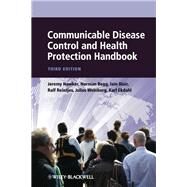Communicable Disease Control and Health Protection Handbook
, by Hawker, Jeremy; Begg, Norman; Blair, Iain; Reintjes, Ralf; Weinberg, Julius; Ekdahl, Karl- ISBN: 9781444335675 | 1444335677
- Cover: Paperback
- Copyright: 3/12/2012
The term communicable disease control describes the way in which outbreaks of infectious diseases are managed to prevent their transmission and spread. This includes surveillance, prevention, investigation, and response to cases. This book is a practical guide to a very topical subject. In the past five years, there have been changes in several areas of health protection practice, and there has been significant scientific progress in the field, which should be reflected in a new edition. The current H1N1 flu pandemic, and outbreaks in recent years of avian flu and SARS, have raised the profile of communicable disease control. In Europe the range of diseases and infectious agents differs from that of the US, and yet the only real reference in this field is an American book: Heymann: Control of Communicable Disease Manual. This is published by the American Public Health Association every 5 years and is considered to be a good resource. The problem is that it covers many diseases that do not occur in Europe and omits a number of important European infections. Furthermore, the epidemiological information it gives is based on the US population. It does not consider the public health issues in a European and UK context. This book aims to fill the gap in the European market. The book is divided into 5 sections. After an introductory chapter, there follow problem/symptom-based chapters. The purpose of these is to help the reader approach cases in which the organism is unclear. It covers both differential diagnosis and general measures. The main body of the text is devoted to disease specific chapters. There are 90 of these, and they cover the diseases in a uniform way. The chapters are divided into the following subsections: introduction, epidemiology, diagnosis, transmission, pathogenesis, prevention, surveillance, response to cases, investigation of cluster, and control of outbreak. Text boxes with 'On call actions' and 'Case definition' help the reader to find essential information rapidly. The final section covers communicable disease services. The aim of this section is to set out the basic principles of infection control and provide a context for workers in this field, particularly those that are newly qualified. However, there is also information that will be of interest to the more established professionals, such as dealing with the media. Similar to Heymann, it will be published in a handbook format so that it can be carried around by people on call. The new two-colour layout will allow instant access to the information.






